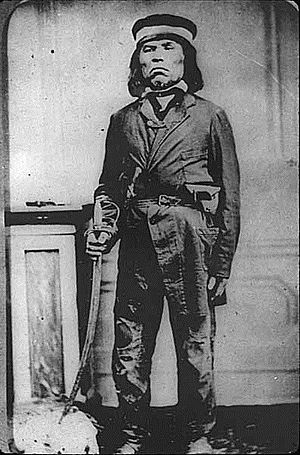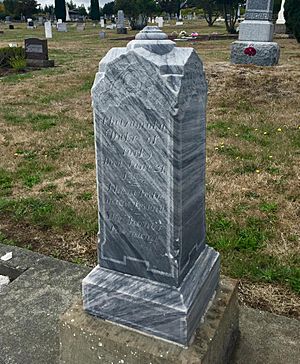Chetzemoka facts for kids
číčməhán (also known as Chetzemoka) was an important leader of the S'Klallam people. He was born in 1808 in a place called KaTai. His parents were Quah-Tum-A-Low and Lach-Ka-Nam, who was the chief of the S'Klallam.
When Chetzemoka was about 40 years old, the first white settlers arrived in Port Townsend, Washington. The settlers found his original name hard to say. So, they started calling him Chetzemoka. They also gave him a special nickname, "Duke of York." His son, La-kaa-nim, was nicknamed "Prince of Wales." Chetzemoka was known for being a wise and peaceful leader.
Contents
Who Was Chief Chetzemoka?
Chetzemoka was a respected leader of the S'Klallam tribe. He was known for his calm and diplomatic way of handling problems. Unlike his older brother, King George, who was often argumentative, Chetzemoka always tried to find peaceful solutions. His brother eventually left the tribe and moved to San Francisco.
Early Life and Family
Chetzemoka's father was a chief, which meant Chetzemoka grew up learning about leadership. He had two wives, See-Hei-Met-za (nicknamed Queen Victoria) and Jenny Lind. His son, La-kaa-nim, later became a chief too. These nicknames show how the settlers saw them as important, like European royalty.
Travels and Friendships
In the early 1850s, Chetzemoka traveled to San Francisco. There, he became friends with a man named James G. Swan. This friendship helped him understand more about the new settlers and their ways.
Chetzemoka as a Tribal Leader
In 1854, the U.S. government recognized Chetzemoka as the official chief of the S'Klallam. This meant he was responsible for keeping peace among his people and with the new settlers.
The Point No Point Treaty
In 1855, Chief Chetzemoka signed a very important agreement called the Point No Point Treaty. Through this treaty, the S'Klallam people gave up much of their land. However, they kept their rights to fish, hunt, and gather food in their traditional areas. Many Native American leaders did not fully understand these treaties. This misunderstanding led to conflicts, including the Indian Wars in 1855-56.
Preventing Conflict in Port Townsend
During the Indian Wars, some S'Klallam people considered attacking the white settlers in Port Townsend. Chetzemoka strongly disagreed with this idea. For nine days, he sent a daily signal from a special rock, warning the settlers of danger. On the tenth day, his signal meant "danger is passed." The S'Klallam decided not to attack.
Chetzemoka's actions saved many lives and made him a hero to the white settlers. Because of his bravery and wisdom, a bronze plaque was placed on Signal Rock. A park in Port Townsend is also named Chetzemoka Park, honoring his legacy.
Chetzemoka's Legacy
Before he passed away, Chetzemoka chose his son, Lach-Ka-Nim (Prince of Wales), to be the next chief. Today, many people in the area have the last name "Prince," which comes from Lach-Ka-Nim's nickname.
Chief Chetzemoka died in 1888. He was buried in the Laurel Grove cemetery in Port Townsend. His life showed how one person could work for peace and understanding between different groups of people.
Honoring His Name
The MV Chetzemoka is a ferry boat operated by Washington State Ferries. It was built in Seattle, Washington, and named after Chief Chetzemoka to honor his important role in the region's history.



